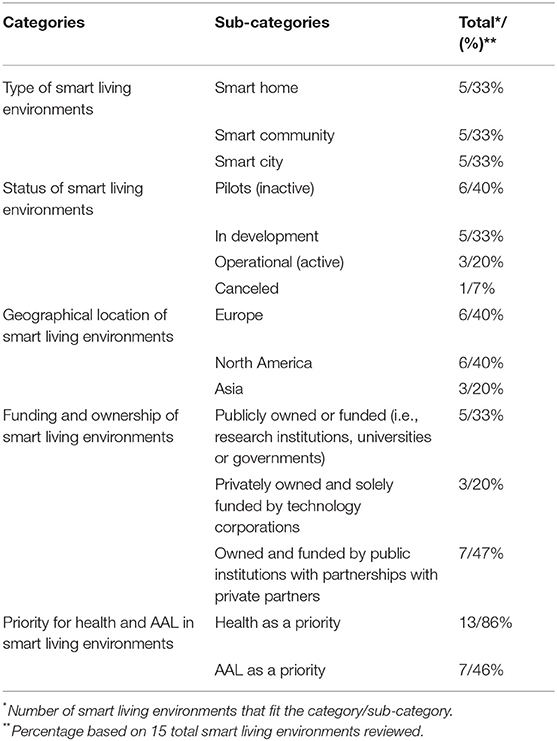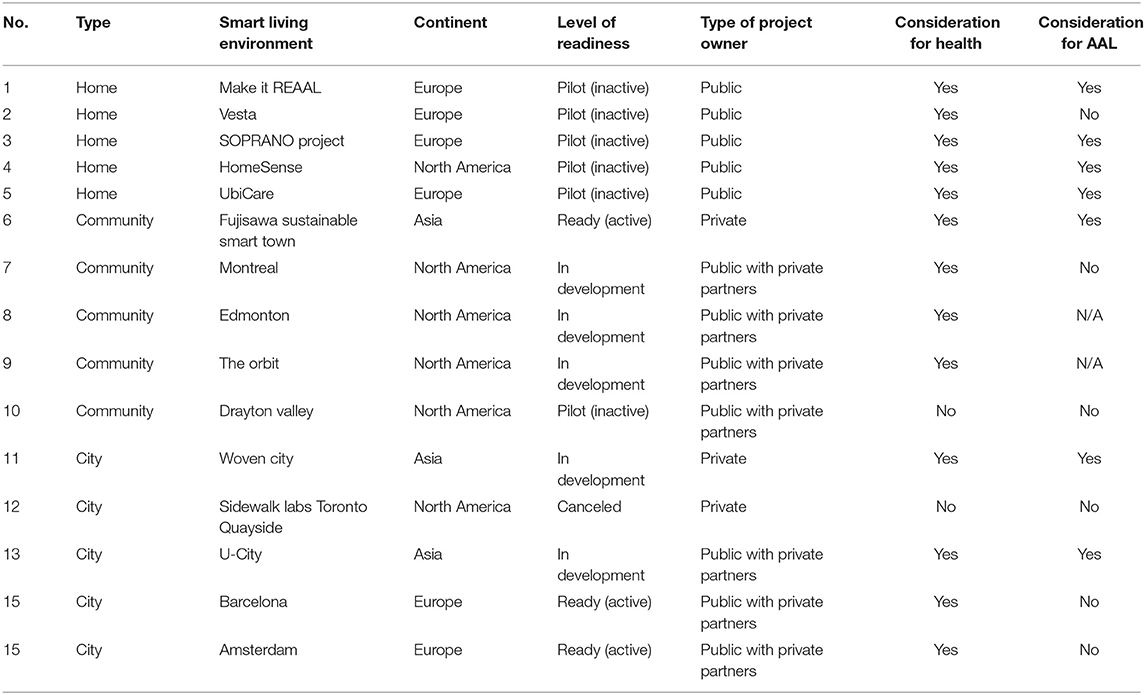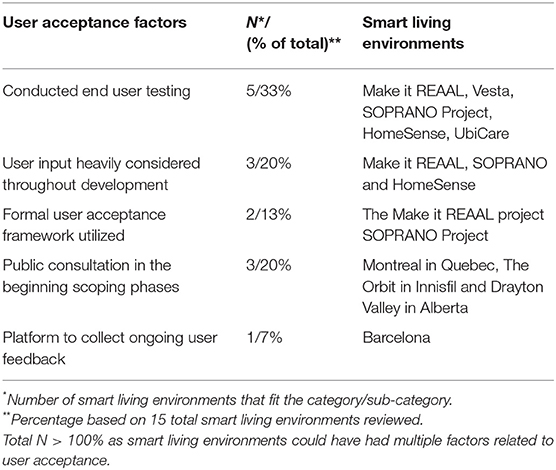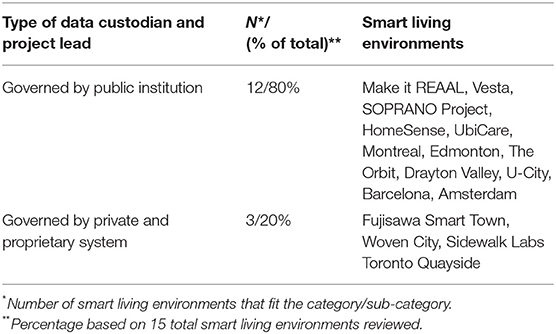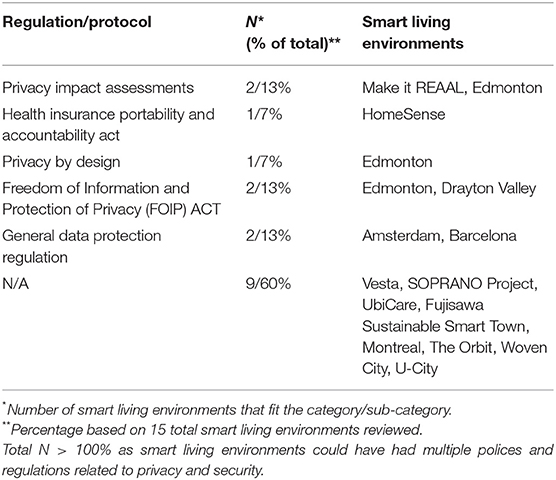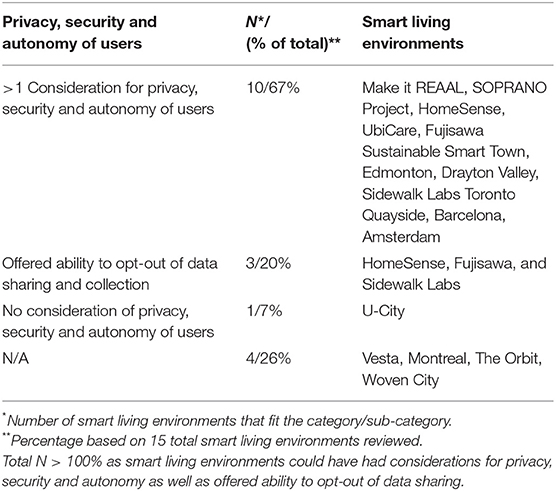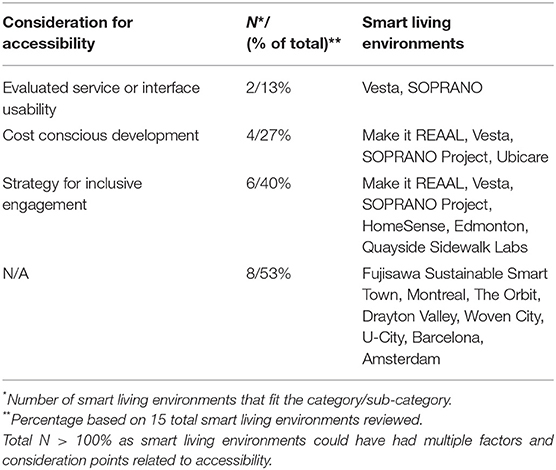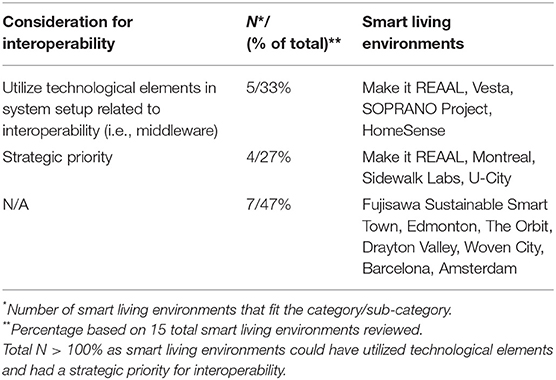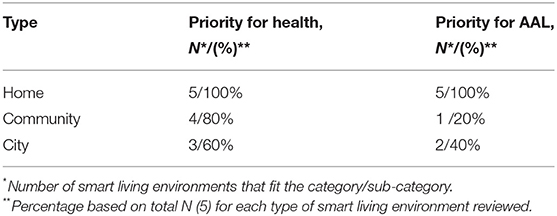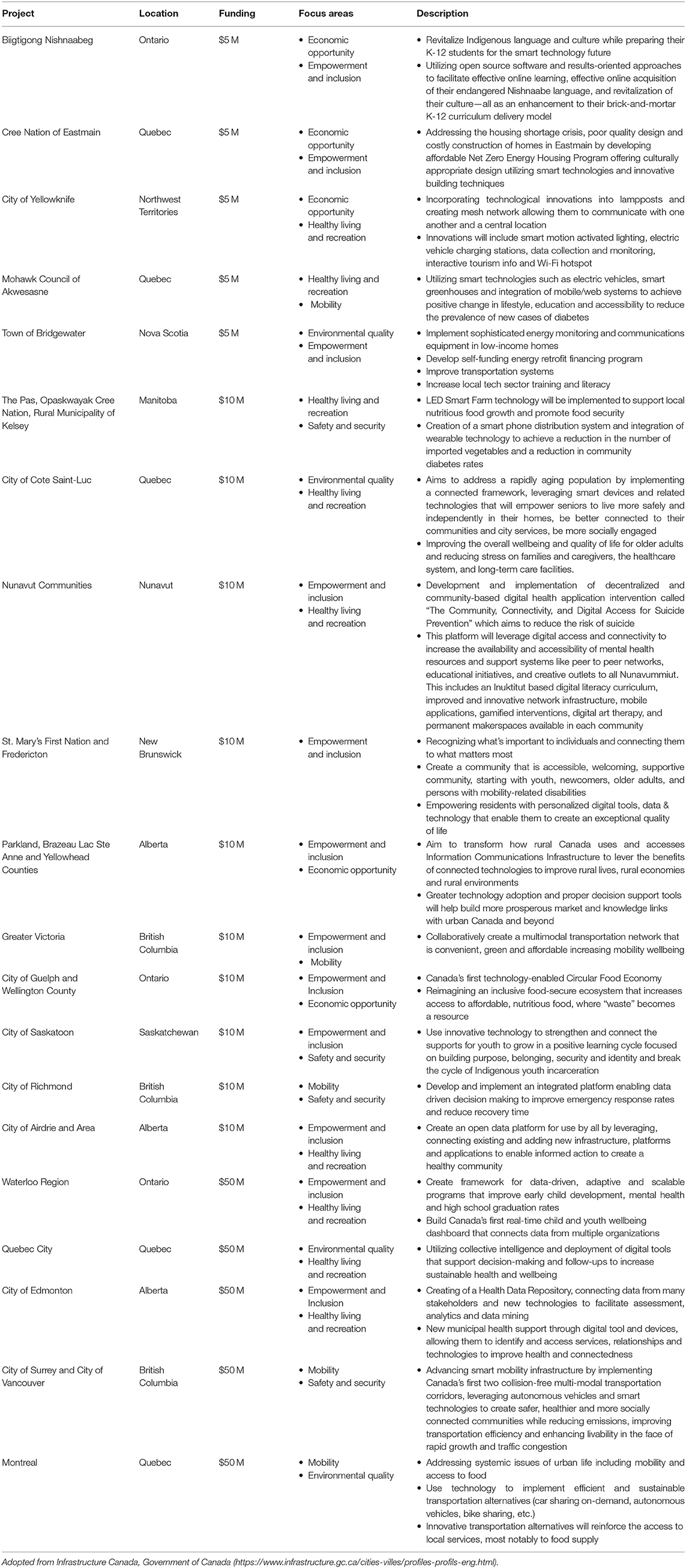- 1School of Health, University of Waterloo, Waterloo, ON, Canada
- 2Research Institute for Aging, University of Waterloo, Waterloo, ON, Canada
- 3Department of Systems Design Engineering, University of Waterloo, Waterloo, ON, Canada
- 4eHealth Innovation, Techna Institute, University Health Network, Toronto, ON, Canada
- 5Institute of Health Policy, Management, and Evaluation, Dalla Lana School of Public Health, University of Toronto, Toronto, ON, Canada
While there have been rapid advancements in individual technologies such as Internet of Things (IoT) and Active Assisted Living (AAL) to address challenges related to an aging population, there remain large gaps in how these technologies can be integrated into the broader ecosystem to support older adults in aging in place. This research provides an overview of 15 solutions available to date around the globe and compares key factors for adoption in each solution, including user acceptance, privacy and security, accessibility, and interoperability. To scale these solutions sustainably and universally, the development and implementation of standards for key factors for adoption in AAL environments is critical. There is also a need for increased and sustainable funding to complement research priorities, to continue advancing AAL technologies.
Introduction
Global population aging is increasing dramatically at an unprecedented pace. It is estimated that the proportion of the world's population over 60 will nearly double from 12 to 22%, between 2015 and 2050 (1). This demographic shift presents challenges to all countries, such as ensuring healthcare and social support systems are adept to meet the increasing needs and demands of an aging population.
The current literature indicates that well-designed technological solutions may act as facilitators to help address challenges related to an aging population (2). As the development of technologies such as Internet of Things (IoT) and Active Assisted Living (AAL) technologies continue to advance, it is anticipated that these innovations will influence future architecture and infrastructure development, giving rise to more smart communities and cities, offering both sensing and actuating capabilities such as assistive interventions for older adults (3–5). Advances in technology can aid in preventing, educating, and monitoring behaviors to assist older adults with their activities of daily living (ADL) and support them in learning and remembering healthy behaviors (6). Furthermore, technologies can help older adults remain in the community, shifting to a more decentralized model of care, which can present cost-savings for healthcare systems, yet more effective patient-centered care (7).
While there have been promising advancements, there is limited research available on the key challenges in scaling assistive communities to meet the needs of older adults for active and successful aging. In this article, we provide an overview of the key factors for adoption of AAL technologies and highlight 15 case studies of solutions from around the globe. As a secondary insight, we provide a comparison between the state of AAL globally compared to within the Canadian context.
Materials and Methods
In this research, a narrative literature review was conducted followed by a document analysis to synthesize the current state of knowledge of AAL systems. For the narrative review, select papers included those published in peer-reviewed journals in English. The data sources included Google Scholar, PubMed, PsycINFO, Cochrane Library, and Scopus. The inclusion criteria for the research focused on AAL communities in any stage of deployment that assessed or mentioned at least one of the following factors: user acceptance, privacy and security concerns, accessibility, and interoperability, which are factors derived from Design for All framework (8, 9). The Design for All framework is a holistic paradigm that considers a broad spectrum of human diversity (9). It proposes flexible designs, offering universal features easily adapted to the needs of a specific user (9).
For the document analysis, documents from Google, including reports published by institutions, industry, governments, and independent research groups, were analyzed. Books, background papers, program proposals, application forms, summaries, and manuals were also included in the analysis.
The four factors selected for comparison and analysis of the AAL communities have been previously identified in the literature as key factors for consideration when deploying AAL systems. The themes for analysis are described below.
User Acceptance
User acceptance is an important aspect for the successful adoption of health technologies. Acceptance of new technologies depends on perceived risks, including whether the technology delivers services in a secure, reliable, and effective manner (10, 11). The results in Offermann-van Heek et al. suggested that “personal care needs” were a parameter that potentially influenced AAL technology acceptance in older adults (12, 13). Higher needs for care would lead to higher acknowledgments of the technology's benefits.
Privacy and Security
Privacy and security issues have been widely cited as concerns by users as AAL technologies monitor, communicate and provide services based on a full-time surveillance basis (14). AAL systems collect and analyze an immense amount of sensitive information about users, including medical and behavior pattern information (15). The use of privacy protection standards is important for respecting a person's autonomy, as well as for building and promoting trust (16). Standards and methodologies such as Privacy by Design should be utilized during the early stages of a system design. This helps ensure that end user privacy concerns are taken into consideration and influence the design of the overall system architecture (17).
Accessibility
Accessibility refers to the degree to which different entities such as a device, interface, resource, system, environment can be used and provide a benefit for as many people as possible (18). The term “accessibility” is often used in the context of people with physical disabilities and their right to access available products and services. However, accessibility is influenced by a multitude of interconnected factors ranging many levels of impact, such as physical, mental, behavioral, social, and environmental (18). It is imperative that AAL systems have a broad range of intelligent functions to support usable and accessible interfaces with adaptive mechanisms for user interactions (19).
Interoperability
The current landscape of AAL systems and environments is highly fragmented due to a lack of reference standards in AAL systems and competition between different vendors (20). Interoperability is recognized as a key requirement for the deployment of successful products in AAL environments as systems and devices must be highly integrated to provide users with comprehensive and effective services (21). In addition, there are upfront costs associated with implementing AAL systems, including but not limited to hardware and software costs and installation fees. From a user's perspective, it is important that the AAL systems are “future-proof” in terms of the possibility to grow and adapt to users' changing needs over the years (21, 22).
Results
Smart Living Environments (SLEs) Around the Globe
The results include an analysis of 15 smart living environments around the globe; six located in Europe, six located in North America and the remaining three located in Asia (Table 1). Of the 15 environments, five are smart homes, five are smart communities and five are smart cities (Table 2). Six of the environments were pilots, which are now inactive; five are currently in development; three are currently operational and active and one project was canceled (Table 1).
Project Ownership
Within the 15 smart living environments, five are publicly owned and funded either by research institutions, universities, or governments. Three are privately-owned and solely funded by technology corporations. Lastly, seven are owned and funded by public institutions with partnerships with private partners to provide technological capacity and infrastructure (Table 1).
Priority for Health and AAL
Out of the 15 smart living environments, 13 had health as a priority. Of those thirteen, five are smart homes, four are smart communities and four are smart cities (Table 1). Beyond health, AAL was a priority in four smart homes, one smart community and two smart cities (Table 1). Technologies included in smart living environments enabling health and AAL include both ambient and wearable sensors to help visualize daily activity and provide real time notification systems to signal adverse events (22, 23).
SLE Analysis for Factors of Adoption
User Acceptance
The level of publicly available information and understanding of user acceptance varied between project owners and funders. Most notably, there was a lack of publicly available information on user acceptance for privately-owned projects that are solely funded by technology corporations. This could potentially be due to non-disclosure agreements between residents and the technology companies.
Regarding end-user testing to understand user acceptance, the richness of data decreased as project sizes increased. At the smart home level, all projects conducted some form of end user consultation and end users were involved in testing in a real-life setting. End users for all five smart home projects were also involved in the early scoping phases. In three out of five projects, user input was heavily considered throughout the entire development process of the platform to iterate on service offerings, prior to implementation (Table 3). Two smart home projects used a framework to evaluate user needs, including the Technology Acceptance Model and The Smart Home Technology Acceptance Model (Table 3).
As the project sizes increased, smart community and city projects had less extensive end user feedback collection cycles, as well as less end user testing protocols. For example, public consultations only occurred in the beginning scoping phases to understand needs and project focus. Three communities collected public responses in the early development phase (Table 3). Only one project developed a platform to collect ongoing feedback from citizens to iterate on service offerings and understand user needs (Table 3). In most cases, it is unclear how public feedback is incorporated into the development and iteration of services as smart living environment projects get larger.
Privacy and Security
As smart living environments collect, retain, and analyze large volumes of personal data, privacy and security become major consideration. Ownership of data, technologies used to ensure encryption and regulations, or policies in place are key themes that emerged when analyzing privacy and security.
Ownership of Data
The data custodian refers to an entity that oversees the storage, aggregation, and use of data sets. In this research, it was found that the primary data custodian oftentimes is dependent on the project owner and the main funder. The results showed that 12 environments were governed by public institutions while 3 environments were governed by a private system. In the smart home projects, data was primarily collected, analyzed, and governed by research teams or public institutions, such as governments (Table 4). In three smart community projects, there were dedicated governing bodies responsible for data ownership.
Technological Elements to Security
There were also different technological methods deployed to encrypt data and keep data secure and private. At the smart home level, technological elements were used in the system's security setup, such as Zigbee and OSGI. Zigbee addresses basic privacy requirements in AAL systems and is a specification that supports message confidentiality, integrity on network and application layers (23). OSGI provides a general purpose, secure support for deploying Java-based service applications, which is utilized in smart living environments (24). In one project, called the Ubicare project in Europe, developers did not use cameras or microphones, as these devices are commonly perceived as privacy violators (23). Rather, unobtrusive sensors were integrated into the physical environment to be minimally invasive (23).
Policies and Regulation
In terms of regulations and policies, there were many methods utilized across the smart living environments. For example, two environments conducted Privacy Assessment Impacts (PIAs) while developing smart environment plans. Only one smart home was Health Insurance Portability and Accountability Act (HIPAA) compliant among the environments collecting health information. Some environments adhered to various protocols including the Privacy by Design approach, the Freedom of Information and Protection of Privacy (FOIP) Act, and the General Data Protection Regulation (GDPR) (Table 5).
User Autonomy
Ten environments considered the security, and autonomy of users. When considering end user autonomy and respecting privacy, only three environments explicitly offered users the ability to opt-out of data sharing and collection (Table 6). Out of the 15 environments, only one did not consider privacy and security implications before implementation while four did not have any information available on their privacy and security policies (Table 6).
Accessibility
There was limited data in the literature discussing accessibility as a priority in smart living environment strategies. In total, six environments had a strategic priority for accessibility (Table 7). Two smart city initiatives—Edmonton (Canada) and Quayside Sidewalk Labs (Canada) had a strategy for inclusive engagement. Moreover, Edmonton had a priority to create a smart city that considered the needs of marginalized groups such as newcomers to Canada, urban Indigenous population, seniors, children, and youth, as well as people living in poverty and homelessness (25). Sidewalk Labs had a priority that combined inclusivity, accessibility, and equitable measures for digital literacy efforts to promote the skills to use the proposed resources (26) (Table 7). Only two smart home projects, evaluated service and interface usability while four smart home projects were more cost-conscious and energy-efficient for end users (Table 7).
Interoperability
Five smart living environments utilized technological elements, such as a middleware, to create an interoperable network for sensors to provide the end user with a comprehensive service (Table 8). Make it REAAL was focused on building their own open-source middleware to provide interoperable services to end users (27). HomeSense utilized an array of networked wireless Z-Wave devices and a Raspberry Pi connected to the internet as a remote gateway (28). Vesta used four Raspberry Pis as gateways and one 4G router (29). Ubicare used Arduino microcontrollers coupled with ZigBee-compatible XBee RF networking modules for wireless communication among the nodes (23). SOPRANO used an open platform based on a combination of semantic-enabled technologies and service-orientation (30). Furthermore, four environments had interoperability as a strategic priority outlined in their strategies and plans (Table 8).
Strategic Priority for Health and AAL
As project sizes increased from the smart home to city level, priority for health and AAL decreased in tandem. All smart homes that were evaluated had a focus on health and AAL. At the smart community level, four out of five projects had health as a priority, but only one also focused on AAL (Table 9). Three smart cities with the largest-sized projects prioritized health while two also focused on AAL (Table 9). More broadly, smart communities and cities were observed to have more of a focus on mobility, renewable and sustainable energy, and overall safety. However, it has been noted in some projects, such as the smart city in Amsterdam, that although health was not a part of the initial strategy, as environments evolve and expand their service offerings, healthcare will be added to the agenda (31).
Funding for the Canadian Smart Living Environment Landscape Compared to the World
Canada has only recently introduced a framework for smart living environments called The Smart Cities Challenge, which began in 2017 with funding results announced in 2019 (32). The Smart Cities Challenge is a pan-Canadian competition, focused on empowering communities to adopt a smart cities approach to improve people's quality of life through innovation, data, and technology (32).
Over 200 communities applied but only 20 were listed as finalists. Out of twenty, nine communities had a focus on healthy living and recreation, two focused on older adults' health, while one specifically proposed AAL in the City of Cote Saint-Luc. The other seven proposals proposed supporting healthy active lifestyles to reduce non-communicable diseases like diabetes, mental health using health data and digital tools for better decision-making support (Table 10). There was a total of $75 million CAD available and four winning spots. When compared to Europe, the EU has provided multiple frameworks and programs for smart city initiatives dating back to 2014. Under the Horizon 2020 framework, the EU funded 15 smart city projects in 2019, providing a total of ~€83 million in funding, which is ~123 million CAD (33).
Canada is currently behind other comparable countries in technology deployment, which is primarily limited to the research and development phase (34). In contrast, the European AAL Programme was introduced by the European Commission to advance innovative research and services for older adults and supports 17 countries with a funding pool of €700 M (35). Canada is now involved in the European AAL Programme, to continue advancing the Canadian AAL landscape.
Discussion
When developing smart living environments, public consultations, and methodologies to frame user-guided iterations of service offerings are critical. This process can increase user acceptance, trust, and adoption. A growing number of studies have emphasized the importance of participatory and user-centered design since decisions on solutions' design, made independently of users can reduce user acceptance (36–38). Yet, a technocentric approach still seems to persist in AAL developments, resulting in solutions that are high-tech but have low impact for end users (39–41). Participatory design and collaboration among the different stakeholders and end users need to be reinforced in projects and policies when developing smart living environments. This approach will help assure the public that integrative smart technologies in living environments are there to complement and support their daily living and not replace human autonomy or capacity.
Furthermore, there is currently no standardization as it relates to privacy and security policies around the world. In Europe, the cities of Barcelona and Amsterdam both utilize The General Data Protection Regulation (GDPR), which is a regulated by the EU and is centered on data protection and privacy. It is regarded as one of the toughest privacy and security laws in the world that deals with the transfer of personal data outside the EU and European Economic Areas [EAA] (40). In comparison, the cities of Edmonton and Drayton Valley in Canada have adopted the Freedom of Information and Protection of Privacy Act (FOIP Act), which is a legislation enforceable only in the province of Alberta.
Interoperability and accessibility standards pose challenges for the development and implementation of smart living environments. As AAL environments are primarily targeted toward older adults and aging populations with diverse needs, accessibility is an area that requires more dedicated attention and advancement. For interoperability to work well, a wide network of service provider stakeholders are required to collaborate on projects to create a product that brings value to end users. However, due to a lack of technical standards, there are challenges when scaling smart living environments and conducting iterations when adding new features and services. In addition, without interoperable standards, vendor lock-in can cause problems for end users such as the inability to consume products that meet all their needs. Vendor lock-in can also drive-up costs and make services inaccessible for users.
Lastly, it's important to recognize that the work contained in this review is limited to materials published in the English language due to the scope of the research project. As such, it is possible that the results cannot be generalized to materials published in other languages and some studies may have been missed.
Conclusion
While there have been rapid advancements in technologies to address challenges related to an aging population and support theories active and successful aging, there is a limited amount real-world deployment of AAL technologies, despite the potential benefits they provide to users. There remain wide gaps and challenges when it comes to scaling and integrating AAL into larger environments such as communities and cities. Most communities are more concerned with addressing areas such as mobility and, renewable and sustainable energy. Canada lags behind in AAL deployment compared to other countries around the world like Europe and Asia. As the research and development process of AAL projects often requires a heavy up-front investment and are primarily led by academic institutions, funding may not be sustainable for long periods of time. Providing sustainable and monetary incentives, such as large pools of funding with the focus of AAL can help increase the innovation, development, and implementation.
Implications
The findings of this study are currently being used in a novel research project that is focused on exploring the continuum between AAL technologies, AAL services, and smart communities. The goal of this project is to develop guidelines for the implementation of smart homes and smart communities that fully leverage the benefits of independent living supported by AAL technology, for use by (i) new AAL technology manufacturers, (ii) developers of new smart communities, and (iii) existing communities seeking to leverage data generated by AAL and IoT sensors into fully integrated community health services. These guidelines will be the product of not only an examination of existing literature, such as what is analyzed in this study, but also focus groups and interviews with relevant actors in the health care sector. An essential component of these guidelines will be the development of a framework for data governance. AAL technologies generate mass amounts of home care-recipient data. Thus, it is important to implement a data governance framework that will ensure the privacy and security of the end-users are prioritized throughout the continuum of care. To develop the framework, it is necessary to identify factors such as independent and dependent variables, relevant actors, collective problems, internal processes, and social norms within the AAL domain. Understanding these factors will in turn unveil data flow requirements, which regulated and unregulated AAL technologies are needed, and how these requirements change as the factors change. With the prioritization of AAL emerging in Canada, such as the newly established Smart Cities Challenge initiative, and involvement in the European AAL Programme, the creation of a data governance framework is critical for the development of smart communities as AAL systems become more complex and integrate more actors. If available, the outcomes of research projects in the European AAL Programme will be considered for the development of guidelines in the subsequent research project.
Author Contributions
LL, PM, and LF: research concept and methodology. LL, AS, and GB: original draft. PM, LF, and GB: review and editing. PM and LF: supervision. All authors contributed to the article and approved the submitted version.
Conflict of Interest
The authors declare that the research was conducted in the absence of any commercial or financial relationships that could be construed as a potential conflict of interest.
Publisher's Note
All claims expressed in this article are solely those of the authors and do not necessarily represent those of their affiliated organizations, or those of the publisher, the editors and the reviewers. Any product that may be evaluated in this article, or claim that may be made by its manufacturer, is not guaranteed or endorsed by the publisher.
References
1. WHO. Ageing and Health. (2018). Available online at: https://www.who.int/news-room/fact-sheets/detail/ageing-and-health (accessed November 12, 2020).
2. Rocha N, Dias A, Santinha G, Rodrigues M, Queirós A, Rodrigues C. A systematic review of smart cities' applications to support active ageing. Proc Comput Sci. (2019) 160:306–13. doi: 10.1016/j.procs.2019.11.086
3. Arroub A, Zahi B, Sabir E, Sadik M. A literature review on Smart Cities: paradigms, opportunities and open problems. In: 2016 International Conference on Wireless Networks and Mobile Communications (WINCOM). Fes: IEEE (2016). p. 180–6. doi: 10.1109/WINCOM.2016.7777211
4. Consel C, Kaye J. Aging with the internet of things. The bridge, National Academy of Sciences. Technol Aging. (2019) 49:6–12.
5. Abril-Jiménez P, Lacal JR, de los Ríos Pérez S, Páramo M, Colomer JBM, Waldmeyer MT. Ageing-friendly cities for assessing older adults' decline: IoT-based system for continuous monitoring of frailty risks using smart city infrastructure. Aging Clin Exp Res. (2020) 32:663–71. doi: 10.1007/s40520-019-01238-y
6. John O, Fallavollita P. Health promotion technology and the aging population. In: Connected Health in Smart Cities. Cham: Springer (2020). p. 179–90. doi: 10.1007/978-3-030-27844-1_9
7. Blackman S, Matlo C, Bobrovitskiy C, Waldoch A, Fang ML, Jackson P, et al. Ambient assisted living technologies for aging well: a scoping review. J Intellig Syst. (2016) 25:55–69. doi: 10.1515/jisys-2014-0136
8. Pieper M, Antona M, Cortés U. Introduction to the Special theme - ambient assisted living. In: Interuniversity Centre for Social Science Theory and Methodology. (2011). http://ercim-news.ercim.eu/en87/special/introduction-to-the-special-theme-ambient-assisted-living (accessed February, 2021).
9. Sacco M, Caldarola EG, Modoni G, Terkaj W. Supporting the design of AAL through a SW integration framework: the D4All project. In: International Conference on Universal Access in Human-Computer Interaction. Cham: Springer (2014). doi: 10.1007/978-3-319-07437-5_8
10. Kleinberger T, Becker M, Ras E, Holzinger A, Müller P. Ambient intelligence in assisted living: enable elderly people to handle future interfaces. In: International Conference on Universal Access in Human-Computer Interaction. Berlin; Heidelberg: Springer (2007). p. 103–12. doi: 10.1007/978-3-540-73281-5_11
11. Safi S, Thiessen T, Schmailzl KJ. Acceptance and resistance of new digital technologies in medicine: qualitative study. JMIR Res Protoc. (2018) 7:e11072. doi: 10.2196/11072
12. Offermann-van Heek J, Schomakers EM, Ziefle M. Bare necessities? How the need for care modulates the acceptance of ambient assisted living technologies. Int J Med Informatics. (2019) 127:147–56. doi: 10.1016/j.ijmedinf.2019.04.025
13. Ziefle M, Rocker C, Holzinger A. Medical technology in smart homes: exploring the user's perspective on privacy, intimacy and trust. In: 2011 IEEE 35th Annual Computer Software and Applications Conference Workshops. Munich: IEEE (2011). doi: 10.1109/COMPSACW.2011.75
14. Wang S, Bolling K, Mao W, Reichstadt J, Jeste D, Kim HC, et al. Technology to support aging in place: older adults' perspectives. Healthcare. (2019) 7:60. doi: 10.3390/healthcare7020060
15. Rothenpieler P, Becker C, Fischer S. Privacy concerns in a remote monitoring and social networking platform for assisted living. In: IFIP PrimeLife International Summer School on Privacy and Identity Management for Life. Berlin; Heidelberg: Springer (2010). p. 219–30. doi: 10.1007/978-3-642-20769-3_18
16. Gerke S, Shachar C, Chai PR, Cohen IG. Regulatory, safety, and privacy concerns of home monitoring technologies during COVID-19. Nat Med. (2020) 26:1176–82. doi: 10.1038/s41591-020-0994-1
17. Caire P, Moawad A, Efthymiou V, Bikakis A, Le Traon Y. Privacy challenges in ambient intelligence systems. J Ambient Intell Smart Environ. (2016) 8:619–44. doi: 10.3233/AIS-160405
18. Queirós A, Silva A, Alvarelhão J, Rocha NP, Teixeira A. Usability, accessibility and ambient-assisted living: a systematic literature review. Univ Access Inform Soc. (2015) 14:57–66. doi: 10.1007/s10209-013-0328-x
19. Hoareau C, Satoh I. Modeling and processing information for context-aware computing: a survey. New Gen Comput. (2009) 27:177–96. doi: 10.1007/s00354-009-0060-5
20. Gambi E, Montanini L, Raffaeli L, Spinsante S, Lambrinos L. Interoperability in IoT infrastructures for enhanced living environments. In: 2016 IEEE International Black Sea Conference on Communications and Networking (BlackSeaCom). Varna: IEEE (2016). doi: 10.1109/BlackSeaCom.2016.7901573
21. Rossi L, Belli A, De Santis A, Diamantini C, Frontoni E, Gambi E, et al. Interoperability issues among smart home technological frameworks. In: 2014 IEEE/ASME 10th International Conference on Mechatronic and Embedded Systems and Applications (MESA). Senigallia: IEEE (2014). doi: 10.1109/MESA.2014.6935626
22. AALiance2, D4,.4 Report on Standards and Certification in AAL (n.d.). Available online at: http://www.aaliance.eu/sites/default/files/files_list/AA2_D4.4_Report_on_Standards_and_Certifications_in_AAL.pdf (accessed February, 2021).
23. Dasios A, Gavalas D, Pantziou G, Konstantopoulos C. Hands-on experiences in deploying cost-effective ambient-assisted living systems. Sensors. (2015) 15:14487–512. doi: 10.3390/s150614487
24. Lee C, Nordstedt D, Helal S. Enabling smart spaces with OSGi. IEEE Pervasive Comput. (2003) 2:89–94. doi: 10.1109/MPRV.2003.1228530
25. City of Edmonton. Smart Cities Challenge Edmonton Final Proposal. (2019). Available online at: https://www.edmonton.ca/public-files/assets/document?path=CityofEdmontonSmartCitiesProposal_21MB.pdf (accessed February, 2021).
26. Waterfront Toronto. Draft Digital Principles. (2019). Available online at: https://quaysideto.ca/wp-content/uploads/2019/11/Final-Draft-Digital-Principles.pdf (accessed February, 2021).
27. EU CIP. Evaluation, validation evidence report. EUROPA (2016). Available online at: https://ec.europa.eu/eip/ageing/sites/eipaha/files/results_attachments/20160803_d5-3_evaluation-validation-and-evidence-report.pdf (accessed February, 2021).
28. VandeWeerd C, Yalcin A, Aden-Buie G, Wang Y, Roberts M, Mahser N, et al. HomeSense: design of an ambient home health and wellness monitoring platform for older adults. Health Technol. (2020) 10:1291–309. doi: 10.1007/s12553-019-00404-6
29. McConville R, Archer G, Craddock I, Kozlowski M, Piechocki R, Pope J, et al. Vesta: a digital health analytics platform for a smart home in a box. Fut Gen Comput Syst. (2021) 114:106–19. doi: 10.1016/j.future.2020.07.046
30. Wolf P, Schmidt A, Klein M. SOPRANO – an extensible, open AAL platform for elderly people based on semantical contracts. In: 18th European Conference on Artificial Intelligence (ECAI 08). (2008). Available online at: https://www.researchgate.net/profile/Andreas-Schmidt-11/publication/228880133_SOPRANO-An_extensible_open_AAL_platform_for_elderly_people_based_on_semantical_contracts/links/0912f50a27d0abec7c000000/SOPRANO-An-extensible-open-AAL-platform-for-elderly-people (accessed February, 2021).
31. Noori N, Hoppe T, de Jong M. Classifying pathways for smart city development: comparing design, governance and implementation in Amsterdam, Barcelona, Dubai, and Abu Dhabi. Sustainability. (2020) 12:4030. doi: 10.3390/su12104030
32. Government of Canada. Smart Cities Challenge. (2020). Available online at: https://www.infrastructure.gc.ca/cities-villes/index-eng.html (accessed February, 2021).
33. European Commission. Horizon 2020. (2020). Available online at: https://ec.europa.eu/inea/en/horizon-2020 (accessed February, 2021).
34. Fadrique LX, Rahman D, Morita PP. The Active Assisted Living Landscape in Canada Insights for Standards, Policies, and Governance. Available online at: https://www.csagroup.org/wp-content/uploads/CSA-Group-Research-AAL.pdf (accessed February, 2021).
35. AAL Programme. Active Assisted Living Programme – Objectives. AAL Programme (2018). Available online at: http://www.aaleurope.eu/about/objectives/ (accessed February, 2021).
36. Peek ST, Wouters EJ, Van Hoof J, Luijkx KG, Boeije HR, Vrijhoef HJ. Factors influencing acceptance of technology for aging in place: a systematic review. Int J Med Inform. (2014) 83:235–48. doi: 10.1016/j.ijmedinf.2014.01.004
37. Lindsay S, Jackson D, Schofield G, Olivier P. Engaging older people using participatory design. In: Proceedings of the SIGCHI Conference on Human Factors in Computing Systems. Elsevier Ireland Ltd. (2012). p. 1199–208. doi: 10.1145/2207676.2208570
38. Röcker C. User-centered design of intelligent environments: requirements for designing successful ambient assisted living systems. In: Central European Conference on Information and Intelligent Systems. Austin, TX: Faculty of Organization and Informatics Varazdin (2013). p. 4.
39. van Gemert-Pijnen JE, Nijland N, van Limburg M, Ossebaard HC, Kelders SM, Eysenbach G, et al. A holistic framework to improve the uptake and impact of eHealth technologies. J Med Internet Res. (2011) 13:e111. doi: 10.2196/jmir.1672
40. European Union. What Is GDPR, the EU's New Data Protection Law? (2021). Available online at: https://gdpr.eu/what-is-gdpr/ (accessed February, 2021).
Keywords: Active Assisted Living (AAL), aging in place, smart city, ambient assisted living, smart living
Citation: Lam L, Fadrique L, Bin Noon G, Shah A and Morita PP (2022) Evaluating Challenges and Adoption Factors for Active Assisted Living Smart Environments. Front. Digit. Health 4:891634. doi: 10.3389/fdgth.2022.891634
Received: 08 March 2022; Accepted: 04 April 2022;
Published: 30 May 2022.
Edited by:
Benjamin Schooley, University of South Carolina, United StatesReviewed by:
Paraskevi Papadopoulou, American College of Greece, GreeceTonia San Nicolas-Rocca, San Jose State University, United States
Copyright © 2022 Lam, Fadrique, Bin Noon, Shah and Morita. This is an open-access article distributed under the terms of the Creative Commons Attribution License (CC BY). The use, distribution or reproduction in other forums is permitted, provided the original author(s) and the copyright owner(s) are credited and that the original publication in this journal is cited, in accordance with accepted academic practice. No use, distribution or reproduction is permitted which does not comply with these terms.
*Correspondence: Plinio Pelegrini Morita, cGxpbmlvLm1vcml0YUB1d2F0ZXJsb28uY2E=
 Lena Lam
Lena Lam Laura Fadrique1
Laura Fadrique1 Aakanksha Shah
Aakanksha Shah Plinio Pelegrini Morita
Plinio Pelegrini Morita